Easy and tasty no-onion no-garlic South Indian style tomato chutney made with fresh juicy tomatoes, and lentils. A perfect side for idli, dosa, chapati, parathas, and yogurt rice! Here is my vegan tomato chutney recipe with step-wise pictures.
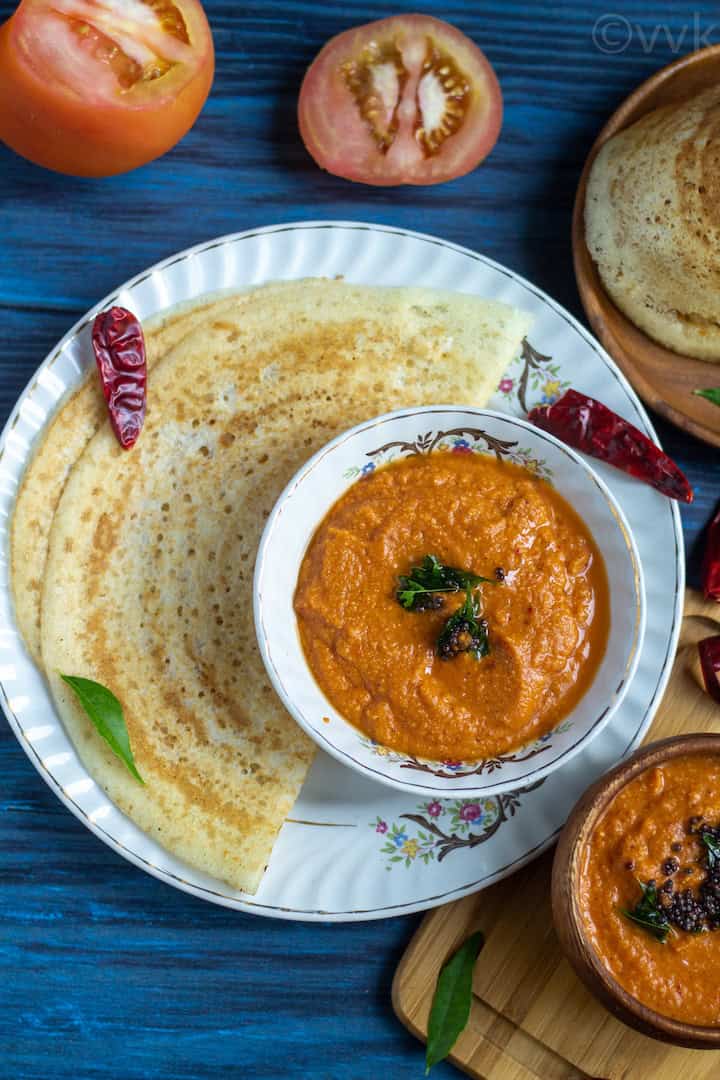
Jump to:
Different sides for idli and dosa-
After sharing the idli-dosa batter recipe, I want to post a simple side for both idli and dosa. I have already shared coconut chutney, tiffin sambar, and sambar for vadai, quick besan sambar, and aka Bombay chutney that you can serve with idli and dosa and other tiffin items. So I thought of sharing this simple tomato chutney now.
In restaurants, you can always find idli or dosa being served with assorted chutneys. My son and I always color code them. White chutney, i.e., the coconut chutney. Red chutney and it can be plain tomato chutney or tomato onion chutney or kaara chutney/spicy chutney and then the green chutney, which can be cilantro/mint chutney or with curry leaves. I will share them all here. But now, let’s see the recipe of this plain tomato chutney without any onion or garlic.
Ingredients required
Lentils: We need an equal measure of chana dal and urad dal. The lentils add texture to the chutney, and I always add lentils to most of my chutneys.
Dried red chilies: We use dry red chilies/chillies to spice up the chutney. Opt for byadgi or Kashmiri red chili variety for a bright red color.
Tomatoes: Use fresh, ripe tomatoes for this chutney. As we are not adding any onion or garlic, fresh and juicy tomatoes are necessary.
Oil and tempering ingredients: We need oil to roast the lentils and saute tomatoes. Also, we need oil for tempering. I went with a simple tempering of mustard seeds, asafoetida, and curry leaves.
We also need salt and asafoetida. This is a vegan and nut-free tomato chutney. Skip the asafoetida for a gluten-free version.
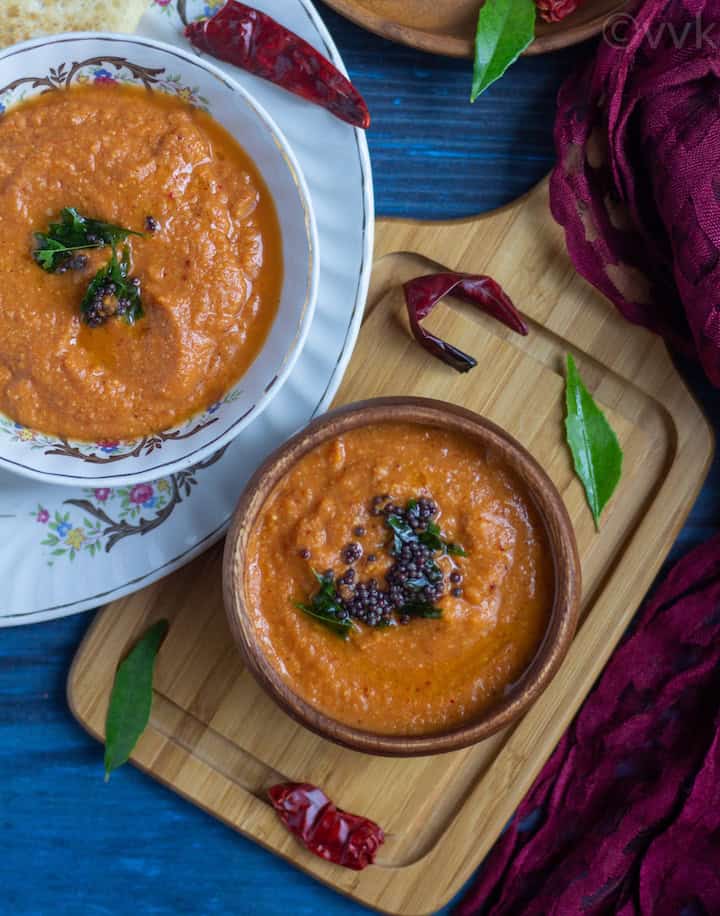
Now let’s see how to make this tomato chutney with step-by-step photos-
How to Make Tomato Chutney (Thakkali Chutney)
Cooking the lentils and tomatoes-
- Heat a pan add the urad dal and chana dal. Roast for a minute and then add the dried red chilies and asafoetida.
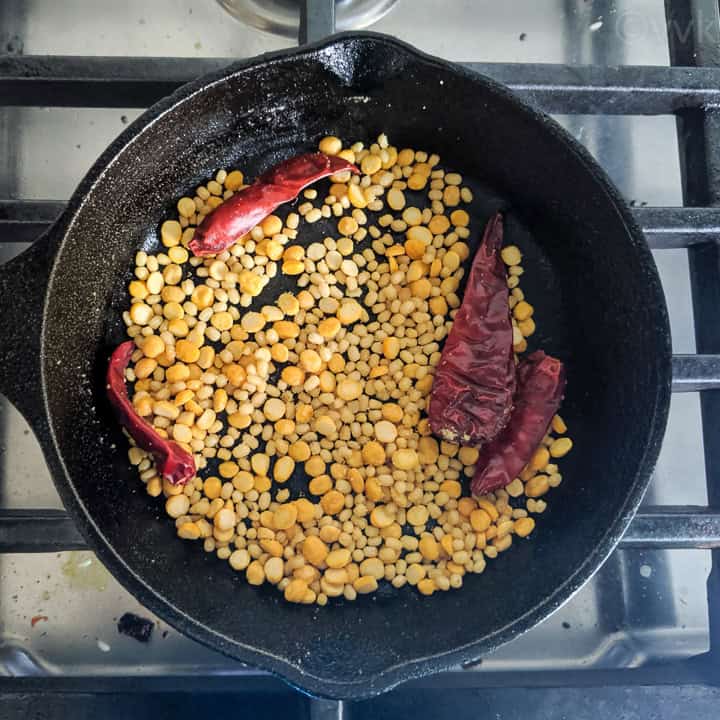
- Roast again over medium heat for 3 to 4 minutes or until the dal turns golden brown. Allow it to cool.
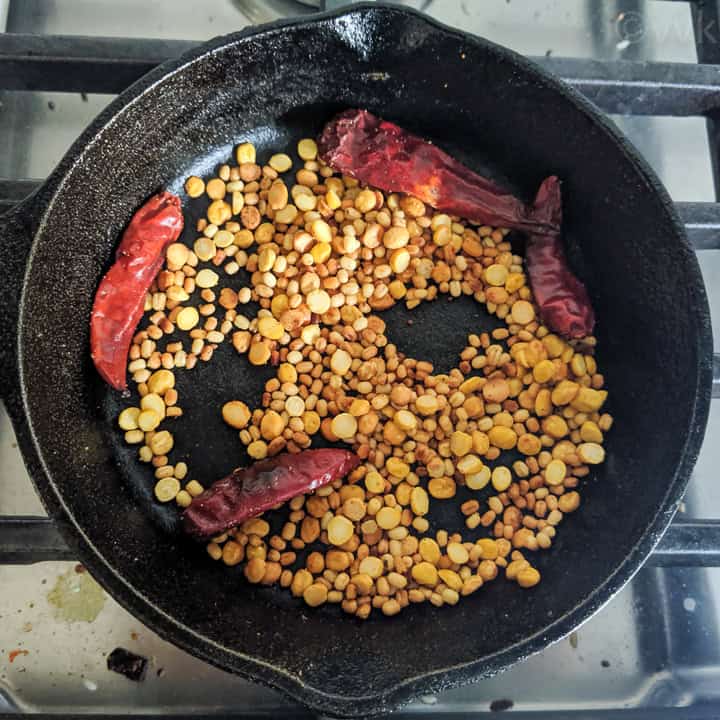
- Now in a separate pan or the same pan (as you can see, I used my small cast iron pan for roasting the lentils and another for tomatoes), add a tsp of oil and heat it. When the oil is hot, add the chopped tomatoes.
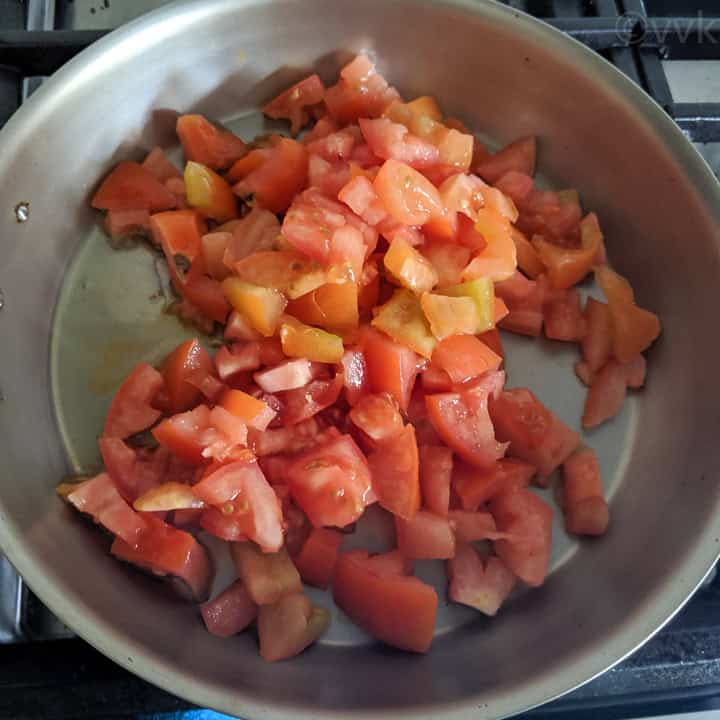
- Let it cook for about 7 to 8 minutes or until they turn soft and bit-mushy. You don’t need to cook until it becomes all mushy as we do for curries. Let it cool.
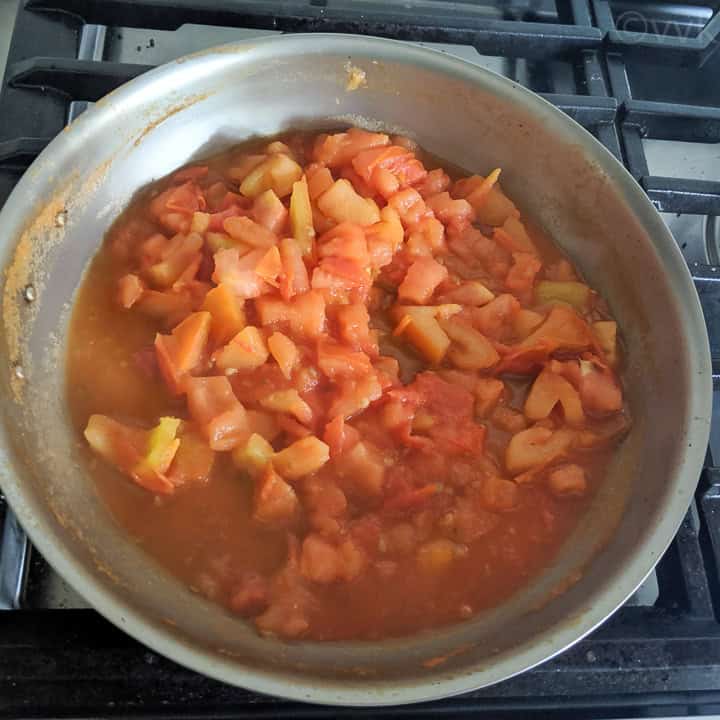
Grinding the chutney-
- First, in a mixer jar or blender, add the lentils and grind it without adding any water. Make sure the lentils are 80% ground. I used my Preethi mixer jar for grinding.
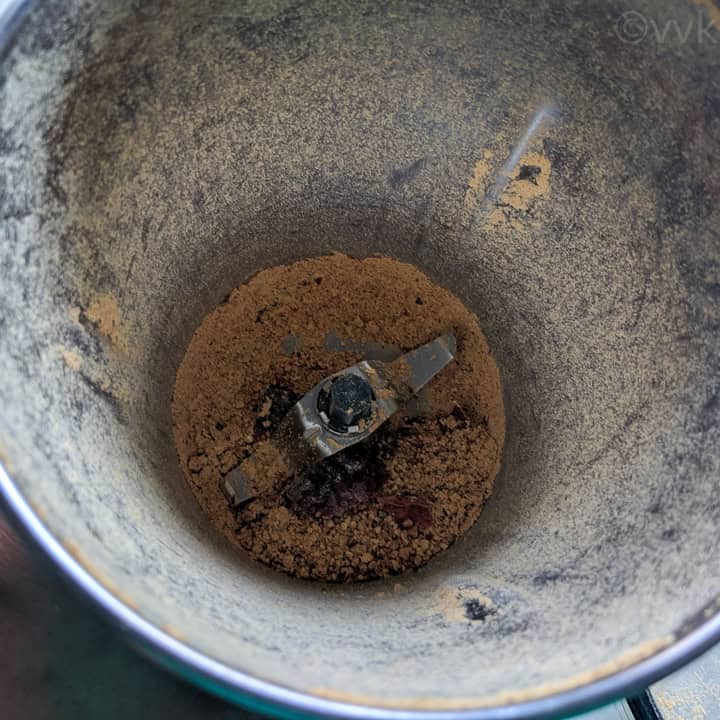
- Next, add the tomatoes and salt. No need to add any water. The moisture from the tomatoes is sufficient to grind the chutney.
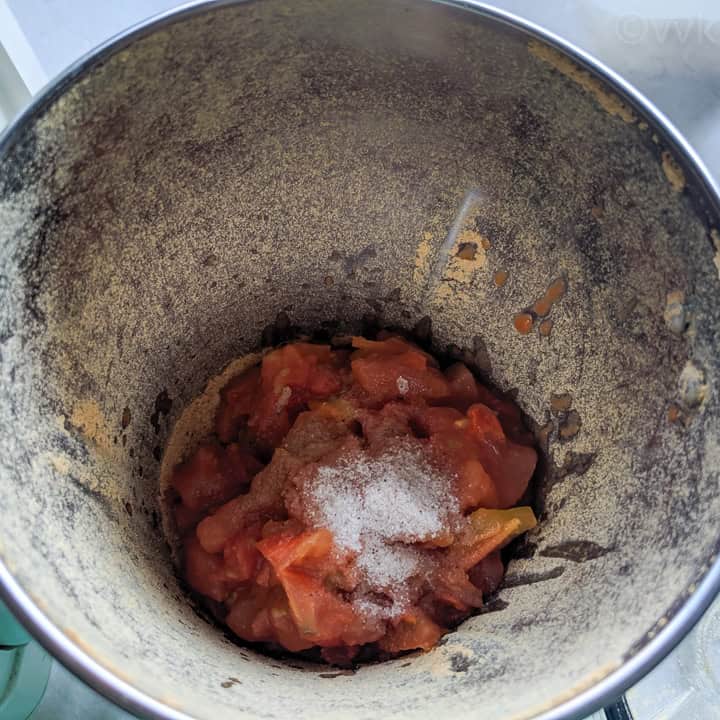
- Grind it smooth or according to your texture preference. Transfer it to a bowl.
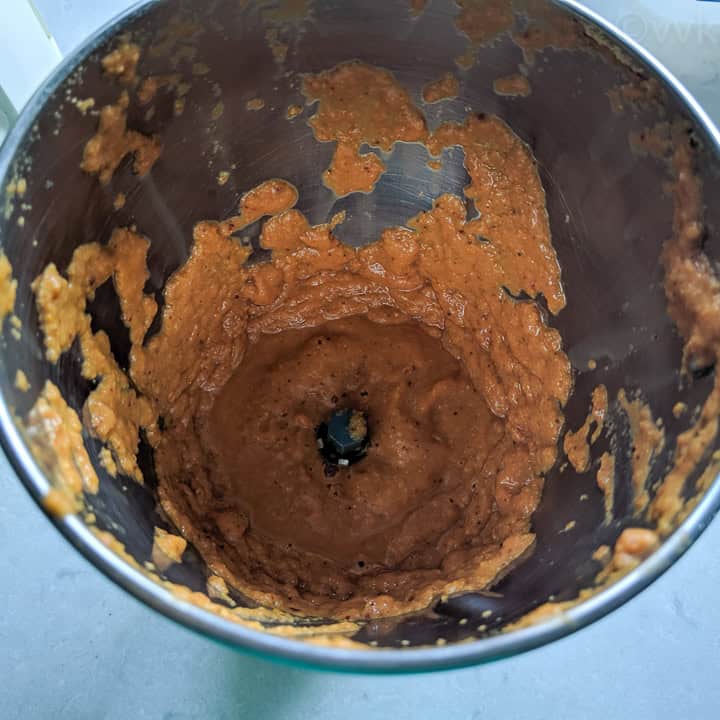
Tempering-
- In a pan, add a tsp of oil and when the oil is hot, add the mustard seeds and curry leaves. When the mustard seeds splutter, add it to the chutney.
- Note – As mentioned before, for longer shelf-life, after the mustard seeds splutter, you can add the ground chutney and saute again over medium-low heat until the moisture is absorbed. I did not do it this time.
Store it in an air-tight container and serve along with idli, dosa, or other tiffin items.

Few key pointers & tips-
- If the tomatoes are not sour, you can add ½ tsp of tamarind paste or a 1-inch piece of tamarind. If you are using tamarind pulp, you can roast it along with lentils, so it softens.
- Adjust the salt and spice according to your preference.
- You can skip the asafoetida and make this tomato chutney a gluten-free one.
- Try Kashmiri or Byadgi variety of chilies for the fiery red color chutney.
- If you can’t source curry leaves, skip the curry leaves. Do not go for substitutes.
- Do not let the lentils turn black. It ruins the taste of the chutney.
- You can check my tomato onion chutney recipe for including onions and garlic.
Serving suggestions
It pairs well with idlis, dosa, uthappam, vada, roti, paratha, and even with yogurt rice. If you want to mix it with rice like thengai thogayal/coconut chutney for rice, increase the red chilies. But if you prefer a mild version, you can go with the same measure.
Increasing the shelf life of this chutney-
When compared to other chutneys, this chutney has a longer shelf life. You can prepare it as a part of your weekend meal prep. When refrigerated, it stays good for up to a week. But if you want to store it outside, you can saute the chutney after grinding it.
My mom usually packs this chutney for me to my hostel during my undergrad days. After making this chutney, she cooks the chutney again with little extra oil and cooks until all the moisture is absorbed. She allows it to cool and packs it in an air-tight container.
In this way, even without refrigerating, it stays for a longer time. I remember using it for up to 5 days. It will be more like thokku/thick chutney, not semi-solid, like in this picture after sauteing.
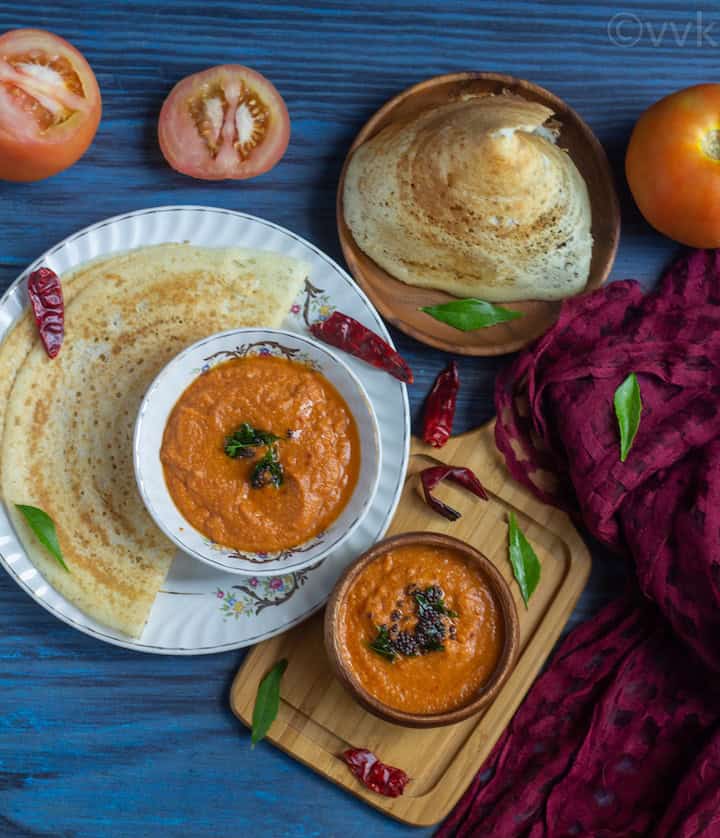
PS: Follow me on Instagram or join my Facebook Group for more gardening and recipe updates. If you try this tomato chutney recipe, please don’t forget to comment and rate this recipe. If you have any questions, please leave a comment, and I will get to it asap. Make sure to follow me on my Pinterest for more healthy and delicious ideas!
Explore other Indian chutney recipes
📖 Recipe
Tomato Chutney | South Indian Tomato Chutney Without Garlic and Onion
Equipment
- Blender / Mixer Jar
- Tawa / Kadai for roasting
Ingredients
Measurement details – 1 cup = 240ml;1 tbsp=15ml; 1 tsp=5ml;
- 2 tsp oil divided
- 3 tomatoes medium-sized / 400 grams/ 2 cups when chopped
- 1 tbsp urad dal whole skinned
- 1 tbsp chana dal
- 4 dried red chilies or to taste
- ¼ tsp asafoetida optional
- 1 tsp salt heaped or to taste
- 1 tsp mustard seeds
- 5 to 6 curry leaves
Instructions
- Heat a pan add the urad dal and chana dal. Roast for a minute and then add the dried red chilies and asafoetida.
- Roast again over medium heat for 3 to 4 minutes or until the dal turns golden brown. All it to cool.
- Now in a separate pan or the same pan (as you can see, I used my small cast iron pan for roasting the lentils and another for tomatoes), add a tsp of oil and heat it. When the oil is hot, add the chopped tomatoes.
- Let it cook for about 7 to 8 minutes or until they turn soft and bit-mushy. You don’t need to cook until it becomes all mushy as we do for curries. Let it cool.
- First, in a mixer jar or blender, add the lentils and grind it without adding any water. Make sure the lentils are 80% ground.
- Next, add the tomatoes and salt. No need to add any water. The moisture from the tomatoes is sufficient to grind the chutney.
- Grind it smooth or according to your texture preference. Transfer it to a bowl.
- In a pan, add a tsp of oil and when the oil is hot, add the mustard seeds and curry leaves. When the mustard seeds splutter, add it to the chutney.
- Note – As mentioned before, for longer shelf-life, after the mustard seeds splutter, you can add the ground chutney and saute again over medium-low heat until the moisture is absorbed. I did not do it this time.
- Store it in an air-tight container and serve along with idli, dosa, or other tiffin items.
Notes
- If the tomatoes are not sour, you can add ½ tsp of tamarind paste or a 1-inch piece of tamarind. If you are using tamarind pulp, you can roast it along with lentils, so it softens.
- Adjust the salt and spice according to your preference.
- You can skip the asafoetida and make this tomato chutney a gluten-free one.
- Try Kashmiri or Byadgi variety of chilies for the fiery red color chutney.
- If you can’t source curry leaves, skip the curry leaves. Do not go for substitutes.
- Do not let the lentils turn black. It ruins the taste of the chutney.
Nutrition
I am not a nutritionist. The nutritional information is provided as a courtesy and is an estimate only. It varies depending upon the product types or brands.
Update Notes: This recipe was originally posted in 2009 but now updated with new pics and recipe cards.




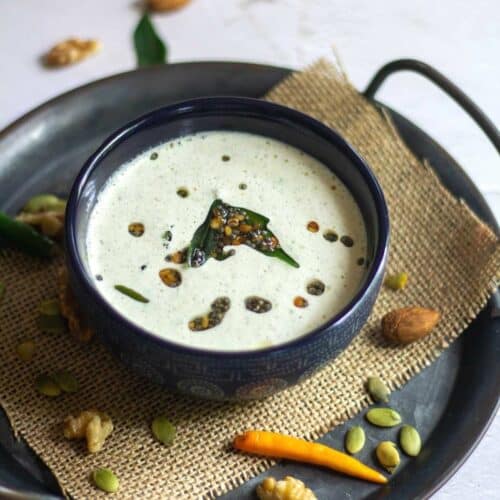
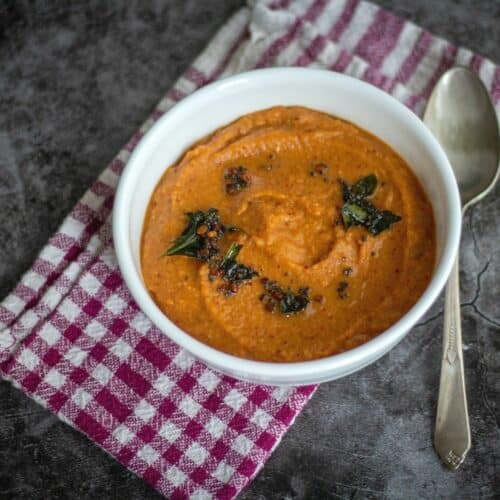
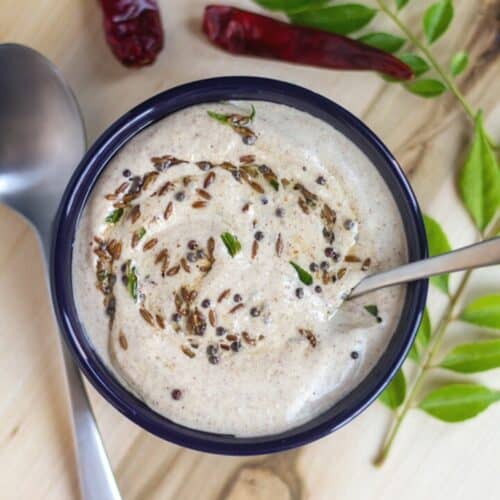


This came as saviour for navarathri times when I can’t add onion and garlic.
Thank you so much
Tried this as you have given.
Tastes excellent. I added a little tamarind paste.
I can mix it with rice like thogayal too and enjoy the
dish. Excellent side dish for dosai and idli. Thanks a lot.
Thanks. Glad you liked it.